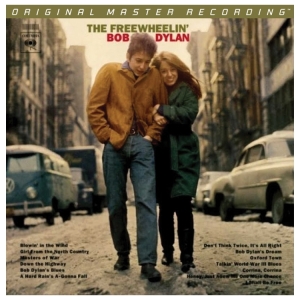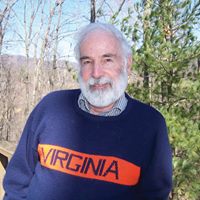
Photo by Beth Hines
I met Bob Friedman in 1962 at the first creative writing class ever offered at the University of Virginia. The small class was established by George Garrett, a significant novelist and poet, who became a mentor to Bob, me, and Henry Taylor, who later won the Pulitzer Prize for poetry. The three of us performed the role of publishers for an anthology of creative writing titled New Writing from Virginia. George Garrett edited the content and Pulitzer poet Richard Wilbur wrote the introduction. Although the small book was privately published, Bob and I were photographed presenting the book to the UVA President in 1963, our graduation year.
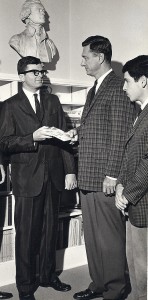
Monty (l) and Bob present a copy of New Writing from Virginia to UVA President Edgar Shannon in 1963 prior to sailing for Europe.
Since I had been to Europe as a 16-year-old third cook on a Norwegian coal freighter, my post graduate goal was to return to Europe and live the expatriate lifestyle of writers like Henry Miller and Ernest Hemingway. Bob liked the idea of the adventure and joined me in booking one-way freighter passage to Europe. Our parents were consoled in our recklessness by the fact that traveling together we might survive. When we enrolled in a graduate school program there, we would also be deferred from the Vietnam War military draft.
Our adventure began in Amsterdam, Holland and continued in Germany, France, England, and finally Denmark and Sweden. We nearly died in a snowstorm while hitchhiking in rural Germany, and we went completely broke and on welfare in Paris when the checks from home could not be cashed.
On the late afternoon of November 22, 1963, Bob and I took a train from London to the town of Virginia Water to be the guests of a friend for dinner at his gentlemen’s club. We were greeted with the news that our President, John F. Kennedy, had been shot; and before we took the midnight train back to London, Kennedy was reported dead. Everywhere we went on our trip to Denmark, flags were at half-mast, and when we were recognized as Americans, people tried to console us. For Bob and me, it was an especially bonding experience.
Later, Bob in Copenhagen and I in Stockholm did not get the university credits necessary to preserve our deferred draft status. Bob rushed back to the States, and George Garrett got him accepted into the MFA writing program at the University of North Carolina at Greensboro within twenty-four hours. I remained confident that a major leg surgery done four years earlier would keep me out of the Army. I was wrong.
More than a year later I visited Bob at UNC-G as a soldier on leave who expected to go to war in Vietnam as the Plans and Training NCO of an evacuation hospital. I learned on that visit that Bob would never reject me no matter how reckless and desperate I behaved. Bob never judged or turned away a friend. He was unique in that way.
While stationed at Ft. Polk, Louisiana, I had a girlfriend in New Orleans in her last year of becoming a registered nurse. If I could get leave to come to Mardi Gras, she promised to find us a cheap hotel on the parade route. I invited Bob to join the party and help me with the expenses. Bob got a blind date with a girl from the very classy Sophie Newcomb College, and the four of us had a three-day party on a balcony overlooking the major Mardi Gras parade route. Bob and I later married those girls.
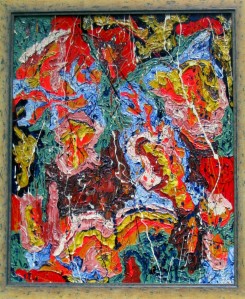
African Delta by Monty Joynes
When I was in Scandinavia, I began to paint in the company of well-established artists of the Bauhaus Situationist movement. Before I was drafted into the Army, I had exhibited my paintings and been recognized in Danish and Swedish media. Back in Norfolk, Virginia after two years of active military service, I opened a small art gallery—Gallery Saint—and failed to make a living as an artist and exhibitor of modern art. Bob had given me money to open the gallery, and he and Donna had attended my one-man show there. For their support, I gave them a painting titled “My Three Sons.” Bob ultimately had three sons—Jonathan, Matthew, and Marc. I am very pleased that they call me Uncle Monty.
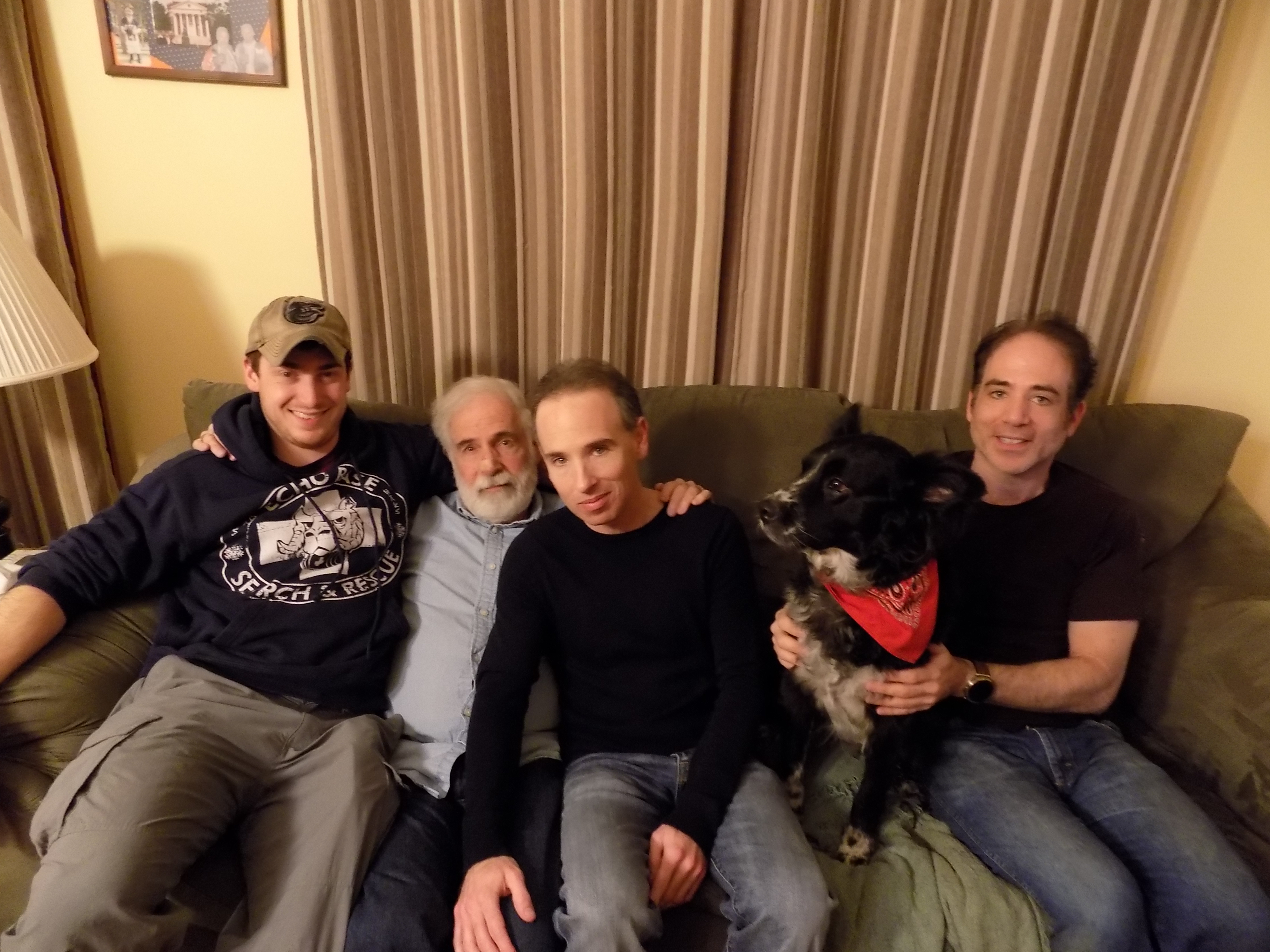
Bob with his three sons Marc, Jonathan, and Matthew
By the time I became self-sufficient and married with a first daughter, Bob took his MFA degree to the University of Wales and began to work on a Ph.D. My extra job in those years was as an international education consultant to the Methodist Board of Higher Education. To promote their summer enrichment program at the University of Graz in Austria, I recommended that we produce a documentary film about the student experience. The only way that the film could be financed, however, was for me to produce, write, direct, and edit it. In planning the production, I arranged for a two-day stopover in London so that Bob and Donna could come from Wales to join my then-wife Theresa and me. When Donna saw the huge bathtub in our gentrified London hotel room, all she wanted to do was to soak off the Wales coal dust from her skin and hair.
The four of us got into the standing-room-only line at the Wimbledon Lawn Tennis Championships to see American Arthur Ashe advance into the semi-finals. Looking for a better option, I used a radio station press card to bluff my way to a set of official press credentials and was given a seat next to the New York Times sports reporter very near the Royal Box. I offered my companions turns-of-use with the press credential, but they would have none of it. Bob loved to tell that story because it proved me to be a colorful character. I was always in comic relief to Bob’s stoicism, but I took pride in being able to make him laugh.
I founded Metro Hampton Roads Magazine in 1970, and by 1971 it was a growing monthly. By 1974, I need editorial help, and Bob, after teaching at East Carolina University, needed a job. He became my Managing Editor. Some of Bob’s staff hires attempted a take-over of the magazine, and I took a month-long vacation to prove that they were not qualified. The owner, seeing that the magazine would miss its printer deadline, called me back to fix the problems. I immediately fired Bob and his staff. My best friend! Years later, while visiting Bob in Charlottesville, his housemate was very surprised to learn of the firing.
“You fired Bob?”
“Yes,” I admitted.
“Why?”
“I had to so that he could publish my books.”
During our work together at Metro, Bob also contributed photos published in the magazine, including cover shots. For a cover shot about the funeral business, I lowered Bob into an open grave, and he shot the grisly real gravediggers looking down at him. I paid the gravediggers $5 each, and we walked away and kept silent until Bob started screaming to be pulled up. We had gone to the cemetery hoping for a picture opportunity. What we got was fantastic. Bob, however, never laughed when I told that story.
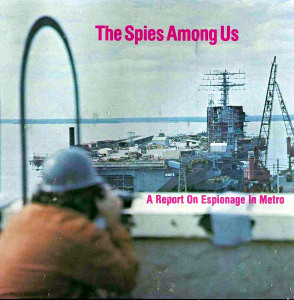 Another fine mess that I got Bob into was the cover and interior shots for “The Spies Among Us.” I took Bob to a rooftop overlooking the Newport News Shipyard where an aircraft carrier and a nuclear submarine were under construction. We were acting like spies to prove a point. The magazine attorney warned us to inform the government before the pictures were published. The Navy, the Pentagon, and the FBI went crazy when they saw the pictures. Some of the photos were rejected, but the magazine was ultimately published on schedule, but at the last minute. There was a week, however, when Bob thought that we might end up in Federal prison.
Another fine mess that I got Bob into was the cover and interior shots for “The Spies Among Us.” I took Bob to a rooftop overlooking the Newport News Shipyard where an aircraft carrier and a nuclear submarine were under construction. We were acting like spies to prove a point. The magazine attorney warned us to inform the government before the pictures were published. The Navy, the Pentagon, and the FBI went crazy when they saw the pictures. Some of the photos were rejected, but the magazine was ultimately published on schedule, but at the last minute. There was a week, however, when Bob thought that we might end up in Federal prison.
Soon after Metro, Bob founded The Donning Company and established it as the major publisher of pictorial history books in the country. I had left Metro to become Associate Publisher of Holiday, the national travel magazine, and then returned to Metro under new ownership. I quit within a year to pursue personal writing projects.
More to the point, I was a divorced would-be novelist living in a second-rate apartment which happened to be a block away from the Donning offices. Realizing my humbled circumstances, Bob hired me as an acquisition editor. I traveled to cities and towns as distant as Dover, Delaware and Bradford, Pennsylvania to find local historians and owners of photo collections who I could put together for a pictorial history.
When I began to write my first novel and had a manuscript, who did I show it to? Bob, of course. Bob read almost every novel that I ever wrote, some 22 of them. He never offered any criticism, but he always encouraged. By the time I asked him to read my fourth unpublished novel, Naked Into The Night, Bob was co-founder of The Hampton Roads Publishing Company located in Virginia Beach.
Years had passed, and I was happily remarried and relocated to Boone, NC in the Blue Ridge Mountains. I had found my life’s companion, Pat, after spending a year of spiritual retreat mostly in silence. I did not want to be the arrogant, judgmental, and violent person that I had become. I wanted a quiet mind. Bob understood my transformation experience; and when I brought him Naked Into The Night, he realized it was the product of a new literary genre that he termed Visionary Fiction.
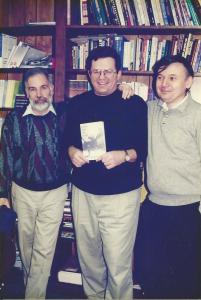
Bob, Monty, and Frank DeMarco
The publication of Naked in 1997 with the back cover genre notation “Visionary Fiction” established Hampton Roads as an innovative fiction publisher in addition to its catalog of Metaphysical and Self-Help books. After Naked, Bob, with partner Frank DeMarco, published Lost in Las Vegas (1998), Save the Good Seed (1999), and Dead Water Rites (2000) in what has come to be termed “The Booker Series.”
When Bob and Frank relocated Hampton Roads to Charlottesville, VA, I became with other HRP authors annual participants in the Virginia Festival of the Book. Bob was by then prominent in the Independent Publishers Association, and he was also a member of the VA Book Festival program committee.
I was a guest in Bob’s home when Neale Donald Walsch visited for the first time. Bob had “discovered” Neale, so to speak, and published what would become the huge worldwide best seller Conversations with God. Bob needed our bed to host Neale and his wife, so Pat and I were sent to a rural B&B that couldn’t have been more grand if it had belonged to Elvis. We had a huge luxury suite, and outdoors were the wonderful amenities of a large swimming pool, a ten-person California redwood hot tub, and a free-standing sauna. The owner-chef was trained at the Cordon Bleu, so we also enjoyed gourmet breakfasts. Poor Neale. If he only knew.
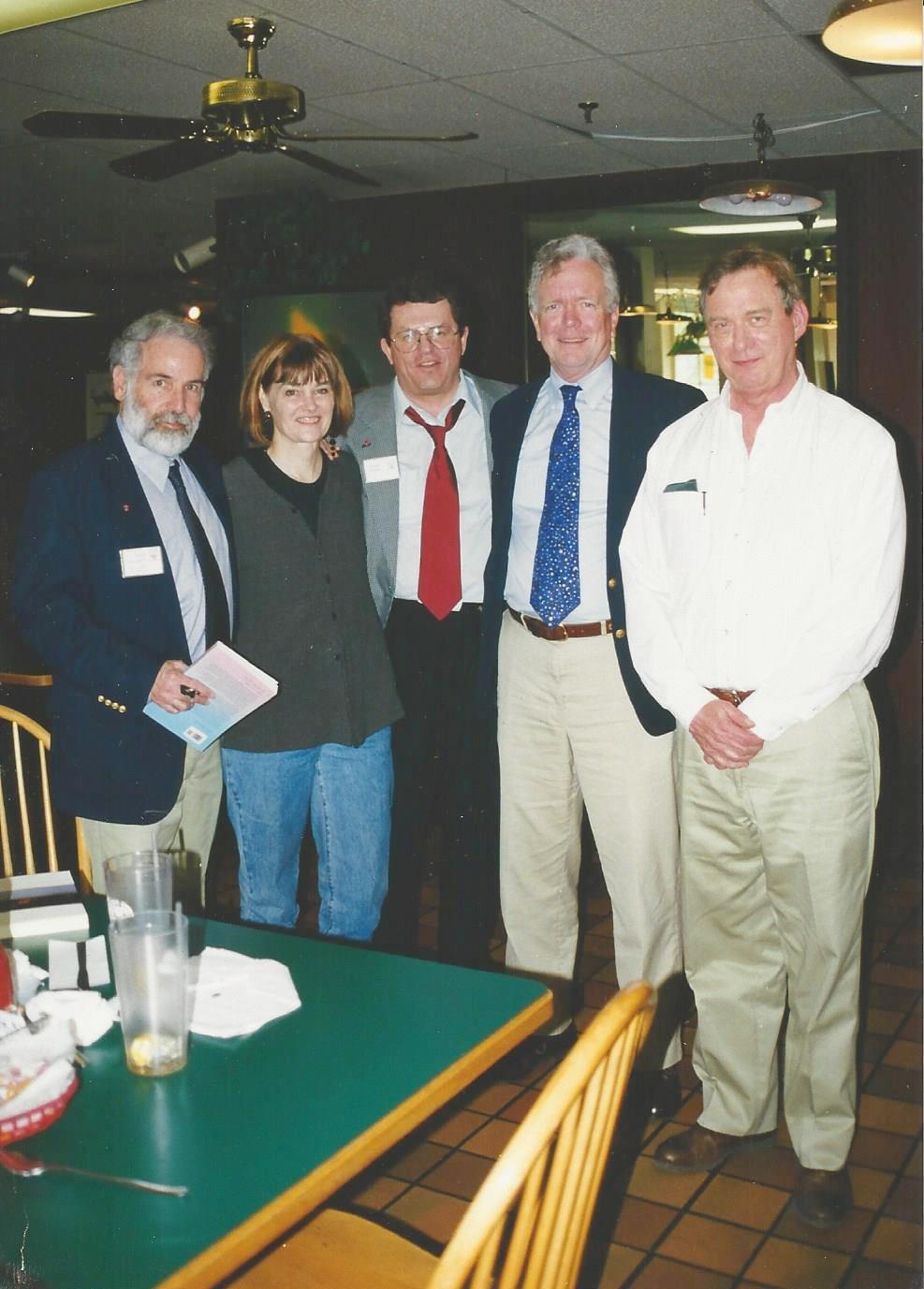
A gathering of friends at the Virginia Festival of the Book. Left to right Bob, Va. Poet Laureate Kelly Cherry, Monty, Pulitzer Prize Poet Henry Taylor, and NC Poet Laureate Fred Chappell.
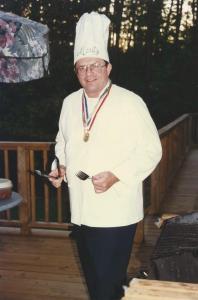
Monty in chef regalia on Bob’s deck at reunions.
Our annual visits to Bob’s residences in the Charlottesville area evolved into a routine. Bob teased me by saying that he didn’t know what he enjoyed more –my books or my cooking. He especially liked my pork tenderloin dinners and my Shrimp Alfredo. Another member of our reunion gang, Ed Catania, cooked another night. His Rosemary Chicken was always prized. Danny Lliteras, one of Bob’s most prolific authors and brother-like friend, and Jonathan and Matt, Bob’s sons, were left to the cleanup.
Another tradition was an afternoon of smoking good cigars and drinking something special like Bailey’s Bristol Cream in the yard or on the deck. None of us were regular smokers, but the cigar smoke seemed to stimulate the conversation and make us laugh.
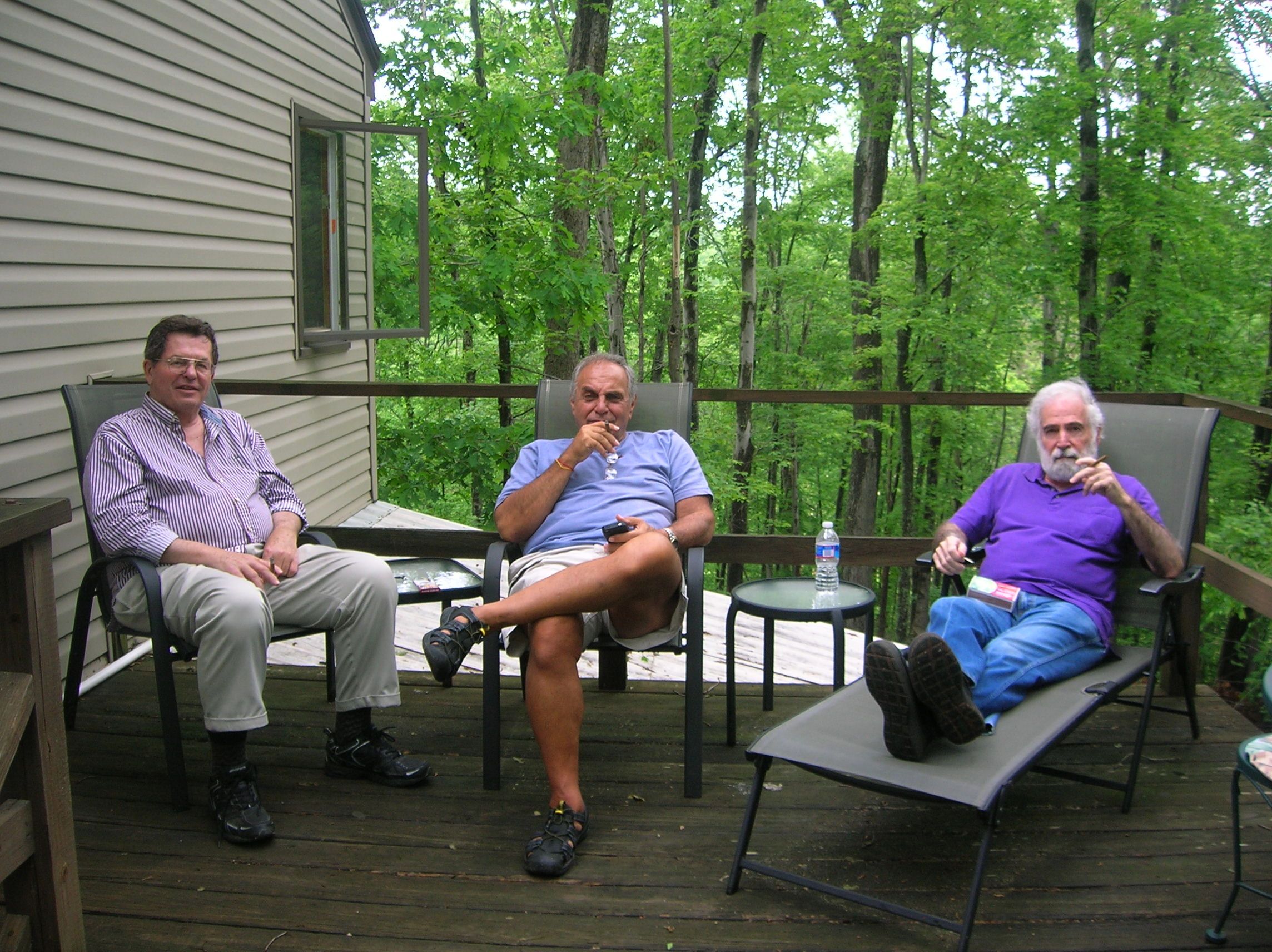
Monty, Ed, and Bob smoking cigars on the deck at Faber
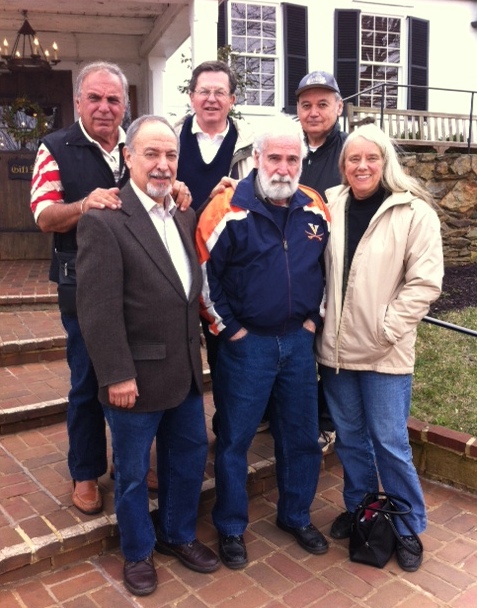
Annual reunion lunch at Michie Tavern. Front row Danny Lliteras, Bob, Beth. Back row Ed Catania, Monty, Frank DeMarco
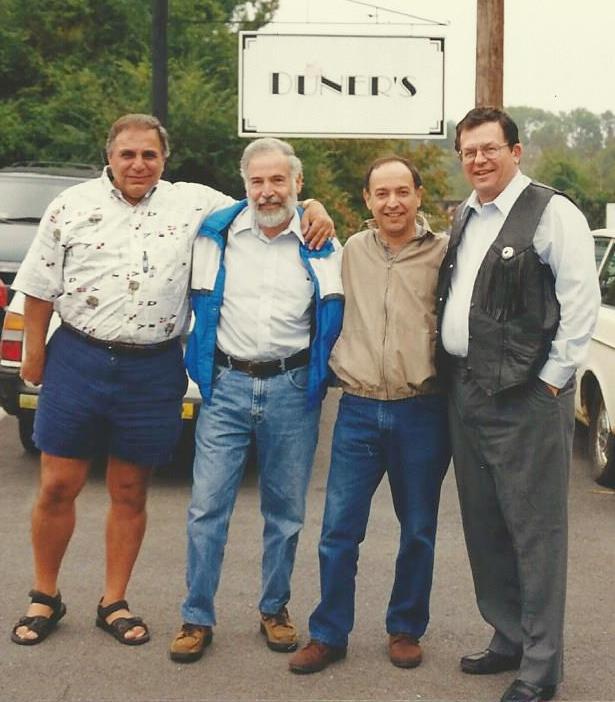
Annual reunion breakfast spot. (l) to (r) Ed Catania, Bob, Danny Lliteras, Monty
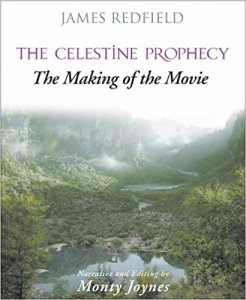
One night after nine, Bob telephoned to ask me to accept a making-of-the-movie book assignment for The Celestine Prophecy, James Redfield’s worldwide best seller. He was still in negotiation, but he needed to assure the movie producer that he could have a credited author on the movie set by the next day. Near midnight, the contract was agreed upon, and the next morning I was on my way to St. Augustine, Florida. I was six weeks on the set for the principle shooting in Florida, and another week months later for post production in Burbank, CA.
The coffee table book with over 160 photographs was published in 2005 in conjunction with the release of the movie, but the film never went into major distribution. It went directly to DVD to retailers. Bob and the producers judged the book to be excellent, but without the success of the movie, it did not sell. My best royalty check came from the German edition.
Bob used the quality of The Celestine Prophecy movie book to convince Neale and 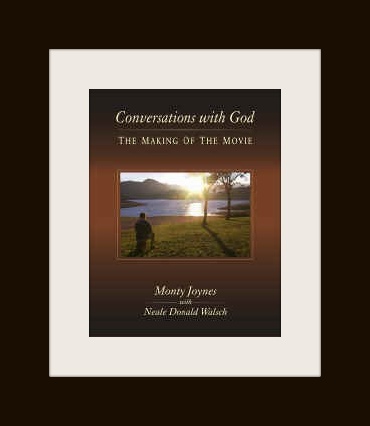 Stephen Simon, producer and director of the movie based on Conversations with God, that I should write and photo edit their making-of-the-movie book. The job took me to Ashland and Medford, Oregon during December where the outdoor sets were so cold that we were issued foot and hand warmers. Disappointing in previews, the feature film never went into major distribution, and thus its movie book failed to sell. I coached the actor who played Bob’s character in the movie on how to be Bob. That was great fun for me.
Stephen Simon, producer and director of the movie based on Conversations with God, that I should write and photo edit their making-of-the-movie book. The job took me to Ashland and Medford, Oregon during December where the outdoor sets were so cold that we were issued foot and hand warmers. Disappointing in previews, the feature film never went into major distribution, and thus its movie book failed to sell. I coached the actor who played Bob’s character in the movie on how to be Bob. That was great fun for me.
Bob may have overestimated my ability to overcome challenges. He knew that I had founded a World Affairs Council, served as an aide to ambassador-level dignitaries, and that I had personal friends in the US Senate, House, and State Department. When Katy, Bob’s second wife, wanted to go to Cambodia to adopt their baby Sophie, Bob recognized it as a potentially dangerous mission. I was caught completely off guard when he made his request.
“If we get in trouble in Cambodia, will you come and get us?”
“Of course,” I responded without pause as if it were within my power.
It was a brief moment without further discussion. I later thought, was there anything that we could not ask of each other? In the retrospect of over 50 years, the answer is self-evident as it is to many in the brother and sisterhood that Bob had established.
In 2013, I stayed at Bob’s home as we attended the 50th Reunion of our 1963 UVA class. The endowment at UVA had already exceeded $1 billion, but still we were solicited for more. Bob and I walked the Lawn together and sat for the presentation of reunion class gifts. Five classes participated. The class older than ours gave over $1 million. Our oversized presentation check was something over $600,000.
I nudged Bob. “Is any of that yours?”
“Nah,” he said. “But I do have to donate a couple of thousand just for the privilege of buying my football tickets.”
“At the lunch table today,” I said, “there was an alumni wife wearing my net worth in her jewelry. They obviously don’t need money from me.”
Bob followed UVA sports, and he wore Cavalier ball caps and Virginia monogrammed sweatshirts and sweaters even when he watched games on television. He persisted in inviting me to home football games. I finally joined him for the first University of Miami ACC game at Scott Stadium. The crowd numbered over 63,000. Getting to and from the stadium was painfully exhausting on my surgically repaired knees. I told Bob that the next time I came to a game, I should land midfield in a helicopter and be taken by golf cart to the skybox elevator. My post-game departure should be the same. Despite my protests, Bob continued to invite me every year.
Pat and I visited Bob and his loving life partner and caregiver, Beth Hines, the week before Thanksgiving (2018). We brought one of Bob’s favorite dishes—my Shrimp Alfredo. I made constant attempts to amuse him, and he smiled and chuckled in the right places and spoke in fragmented phrases. I said, “I love you.” And Bob managed to say, “I love you, too.” The leave taking was very hard.
Back home in Boone, NC, Pat was in daily email contact with Beth, and we tried to comfort her in the ways that we were led. I spoke to Bob twice on the phone, but by that time, it was a one-way conversation. Among our reunion gang, Danny Lliteras visited more than once from Alabama and was a huge supporter for sometimes a week at a time. Ed Catania and wife Angie came from Florida and cooked for Bob and Beth. Author Vernon Kitabu Turner and wife Joyce came from Virginia Beach during the last weeks as others did to comfort Bob and help Beth.
Robert S. Friedman, publisher and best friend, passed this life on January 7, 2019 at his home in Faber, Virginia at the age of 76.
Bob had brought a brother and sisterhood together, and we did not fail to honor him for his many gifts to us. Of course, there were hundreds who called Bob father, brother, and friend. Bob, my true friend for 57 years, led a very significant life. There are a thousand meaningful books that carry the imprint of Bob’s heart and intellect. His legacy will live as long as human beings seek metaphysical truths.
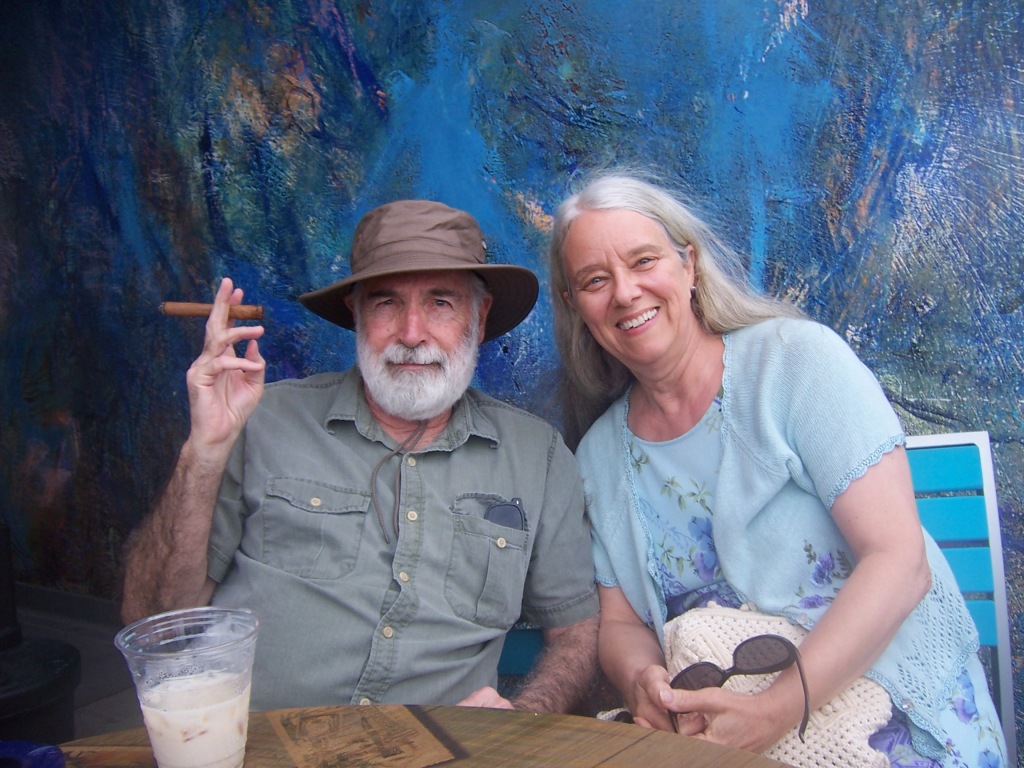
Bob and Beth on Ed Catania’s wedding cruise. Photo by Angie Catania.

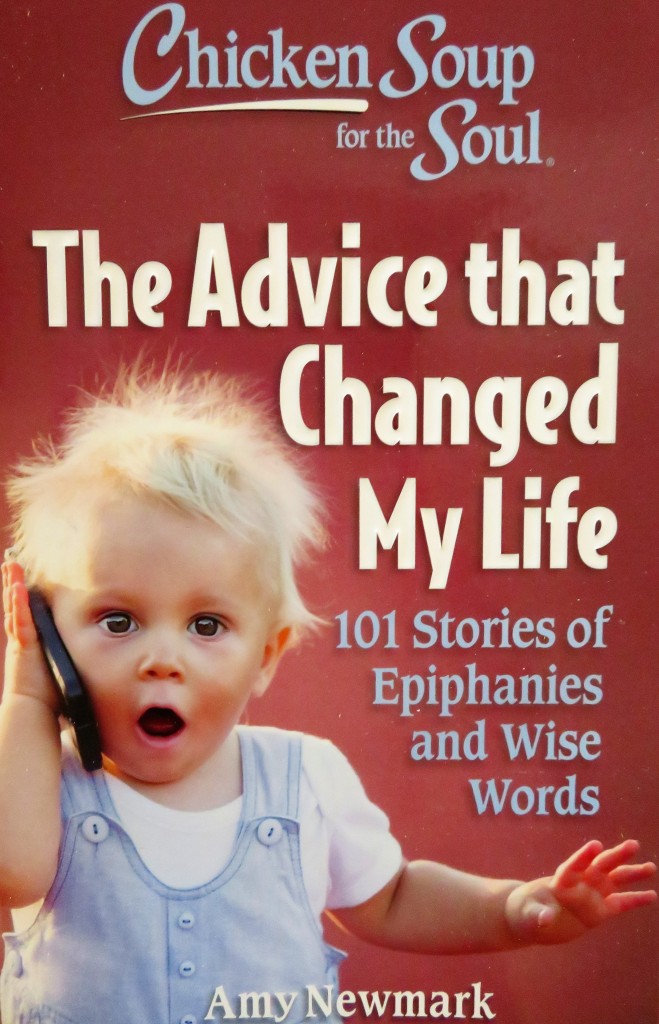
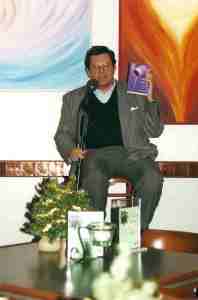




 Another fine mess that I got Bob into was the cover and interior shots for “The Spies Among Us.” I took Bob to a rooftop overlooking the Newport News Shipyard where an aircraft carrier and a nuclear submarine were under construction. We were acting like
Another fine mess that I got Bob into was the cover and interior shots for “The Spies Among Us.” I took Bob to a rooftop overlooking the Newport News Shipyard where an aircraft carrier and a nuclear submarine were under construction. We were acting like 






 Stephen Simon, producer and director of the movie based on Conversations with God, that I should write and photo edit
Stephen Simon, producer and director of the movie based on Conversations with God, that I should write and photo edit 
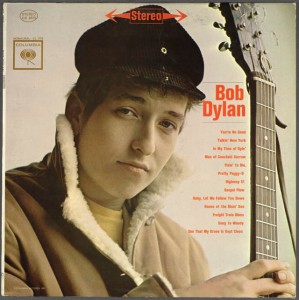 It was a Sunday afternoon at a University of Virginia fraternity house located in a cluster of frat houses that overlooked an intramural field depression known as “Mad Bowl” when I met Bob Dylan and witnessed him rejected as a folk singer and song writer.
It was a Sunday afternoon at a University of Virginia fraternity house located in a cluster of frat houses that overlooked an intramural field depression known as “Mad Bowl” when I met Bob Dylan and witnessed him rejected as a folk singer and song writer.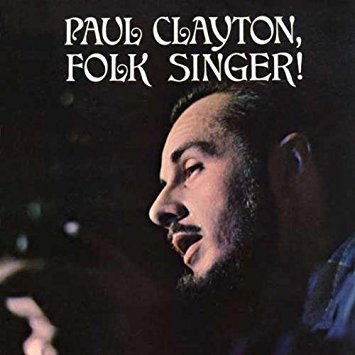 Clayton’s purpose on that Sunday afternoon was to have newcomer Bob Dylan and recorded folk singer Carolyn Hester sing a few songs as a measure of their live performance abilities. It was easy to pull the frat boys away from the ball game on television once they got an introduction to Carolyn Hester. She was 24 years old at the time and Hollywood gorgeous. Hester had already released two albums and was being compared to folk music star Joan Baez. Clayton was helping her with her live performance guitar playing, which was weak at the time. Hester stood against the living room wall and performed two unremembered songs. Her singing was strong and beautiful, but she missed some chords in the accompaniment.
Clayton’s purpose on that Sunday afternoon was to have newcomer Bob Dylan and recorded folk singer Carolyn Hester sing a few songs as a measure of their live performance abilities. It was easy to pull the frat boys away from the ball game on television once they got an introduction to Carolyn Hester. She was 24 years old at the time and Hollywood gorgeous. Hester had already released two albums and was being compared to folk music star Joan Baez. Clayton was helping her with her live performance guitar playing, which was weak at the time. Hester stood against the living room wall and performed two unremembered songs. Her singing was strong and beautiful, but she missed some chords in the accompaniment.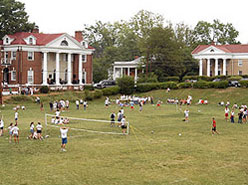
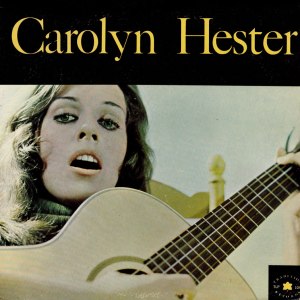 invited Bob Dylan to play harmonica on sessions for her third album at Columbia Records. At a rehearsal session, Dylan met celebrated record producer John Hammond who signed him to a recording contract. Dylan’s first album on Columbia Records was released on March 19, 1962. The album made a great impression in the folk music community, but it was not commercially successful.
invited Bob Dylan to play harmonica on sessions for her third album at Columbia Records. At a rehearsal session, Dylan met celebrated record producer John Hammond who signed him to a recording contract. Dylan’s first album on Columbia Records was released on March 19, 1962. The album made a great impression in the folk music community, but it was not commercially successful.